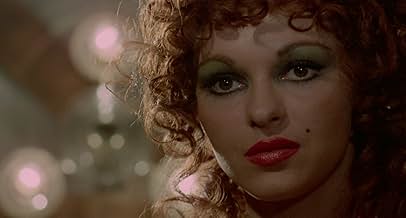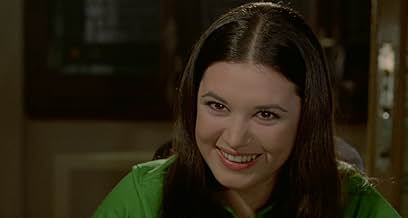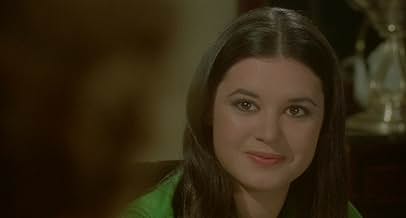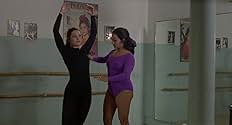Aggiungi una trama nella tua linguaA psychologically damaged young man murders young women who sexually excite him.A psychologically damaged young man murders young women who sexually excite him.A psychologically damaged young man murders young women who sexually excite him.
- Regia
- Sceneggiatura
- Star
Maria Rohm
- Teresa
- (as María Rohm)
- …
Concha Gómez Conde
- Empleada pensión
- (as Concepción Gómez Conde)
Recensioni in evidenza
The Spanish, of course, could never quite do the giallo the way the Italians could, but this example is a real let down. Its a particular shame because this is a bright, colourful print with good subtitles, but oh dear! Mr. Duenas was, apparently, more used to making documentaries and he certainly shows here a distinct lack of skill in directing a thriller. The main premise of the film also makes things very difficult from the very start. Our hero/killer has suffered some traumatic childhood event, and he gets flashbacks, as do we, when he is kissed by a woman. Unfortunately we have to believe that all these women find him so attractive, when he spends his time cringing and sneering. Maybe and just maybe because most Spanish guys are so macho that the ladies find this child like reluctance endearing? I don't know but its no good for us and for the first time ever in one of these movies we never actually get the reveal on what really caused the problem! I have a hunch that this just might have been cut from this print because of adult/child interaction but I'm probably being generous. Inept.
This obscure Spanish thriller from 1975 arrives as a curious artifact of exploitation cinema that hovers uneasily between psychological study and sensationalistic potboiler. Director Jesús García de Dueñas crafts a film that feels perpetually caught between its ambitions and its execution, delivering a work that neither fully commits to serious psychological exploration nor embraces the lurid thrills it occasionally threatens to provide.
The cinematography by Fernando Arribas maintains a workmanlike competence throughout, capturing the grimy authenticity of 1970s Madrid boarding houses and urban landscapes with a functional clarity that serves the story without elevating it. The visual palette leans heavily into muted earth tones and shadowy interiors, creating an appropriately claustrophobic atmosphere that mirrors the protagonist's deteriorating mental state. However, the camera work rarely transcends basic coverage, missing opportunities to delve deeper into the psychological territory the narrative explores.
The film operates as a "workmanlike if uninspired Spanish Giallo," borrowing heavily from Italian thriller conventions while lacking the stylistic flair that made those films memorable. The pacing suffers from uneven rhythms, with stretches of contemplative character development punctuated by moments of violence that feel more obligatory than organic to the story's progression.
The cast delivers performances that range from adequate to problematic. David Carpenter, in the central role of the troubled Julio, brings a certain brooding intensity to his performance, though his portrayal occasionally veers into theatrical territory that undermines the film's attempts at psychological realism. The supporting cast, including the legendary Lola Flores and James Philbrook, provides solid grounding, with Flores particularly effective in her limited screen time. Teresa Rabal offers a naturalistic performance as Monica, the boarding house owner's daughter, though her character development feels constrained by the script's limitations.
The film's exploration of childhood trauma and its psychological ramifications shows promise in its early sequences, but García de Dueñas struggles to maintain the delicate balance between character study and thriller mechanics. The screenplay, co-written with Jesús Torbado, contains moments of genuine insight into the protagonist's fractured psyche, yet these are often overshadowed by more conventional genre elements that feel perfunctory rather than purposeful.
While "the opening works in this Spanish thriller, it features a very uneven cast and the images lack strength," highlighting the film's fundamental inconsistencies. The production values reflect the constraints of its modest budget, with certain sequences feeling rushed or undercooked. The film's brief 85-minute runtime works both for and against it - while it avoids overstaying its welcome, it also prevents the deeper character exploration that might have elevated the material.
The sound design and musical score provide atmospheric support without distinction, creating an appropriately unsettling backdrop for the psychological drama without becoming memorable in their own right. The film's technical aspects maintain professional standards throughout, though they rarely transcend utilitarian functionality.
"El asesino no está solo" represents a missed opportunity to create something genuinely compelling from its provocative premise. While it contains enough psychological complexity to distinguish it from mere exploitation fare, it lacks the courage to fully commit to either its artistic aspirations or its genre obligations. The result is a film that feels curiously distant from its own material, observing its troubled protagonist with clinical detachment rather than the empathy or visceral engagement the story demands.
The cinematography by Fernando Arribas maintains a workmanlike competence throughout, capturing the grimy authenticity of 1970s Madrid boarding houses and urban landscapes with a functional clarity that serves the story without elevating it. The visual palette leans heavily into muted earth tones and shadowy interiors, creating an appropriately claustrophobic atmosphere that mirrors the protagonist's deteriorating mental state. However, the camera work rarely transcends basic coverage, missing opportunities to delve deeper into the psychological territory the narrative explores.
The film operates as a "workmanlike if uninspired Spanish Giallo," borrowing heavily from Italian thriller conventions while lacking the stylistic flair that made those films memorable. The pacing suffers from uneven rhythms, with stretches of contemplative character development punctuated by moments of violence that feel more obligatory than organic to the story's progression.
The cast delivers performances that range from adequate to problematic. David Carpenter, in the central role of the troubled Julio, brings a certain brooding intensity to his performance, though his portrayal occasionally veers into theatrical territory that undermines the film's attempts at psychological realism. The supporting cast, including the legendary Lola Flores and James Philbrook, provides solid grounding, with Flores particularly effective in her limited screen time. Teresa Rabal offers a naturalistic performance as Monica, the boarding house owner's daughter, though her character development feels constrained by the script's limitations.
The film's exploration of childhood trauma and its psychological ramifications shows promise in its early sequences, but García de Dueñas struggles to maintain the delicate balance between character study and thriller mechanics. The screenplay, co-written with Jesús Torbado, contains moments of genuine insight into the protagonist's fractured psyche, yet these are often overshadowed by more conventional genre elements that feel perfunctory rather than purposeful.
While "the opening works in this Spanish thriller, it features a very uneven cast and the images lack strength," highlighting the film's fundamental inconsistencies. The production values reflect the constraints of its modest budget, with certain sequences feeling rushed or undercooked. The film's brief 85-minute runtime works both for and against it - while it avoids overstaying its welcome, it also prevents the deeper character exploration that might have elevated the material.
The sound design and musical score provide atmospheric support without distinction, creating an appropriately unsettling backdrop for the psychological drama without becoming memorable in their own right. The film's technical aspects maintain professional standards throughout, though they rarely transcend utilitarian functionality.
"El asesino no está solo" represents a missed opportunity to create something genuinely compelling from its provocative premise. While it contains enough psychological complexity to distinguish it from mere exploitation fare, it lacks the courage to fully commit to either its artistic aspirations or its genre obligations. The result is a film that feels curiously distant from its own material, observing its troubled protagonist with clinical detachment rather than the empathy or visceral engagement the story demands.
A troubled young man goes around murdering women who sexually excite him.
It's not the most original concept in the world. There have been movies before and since that have dealt with a similar idea. But this Spanish production still registers. It has decent performances and a story that essentially holds up. But more importantly it has a good sense of style. The killer's inner turmoil is shown by flashbacks, close-ups of eyes and eerie music. In the murder scenes all of these elements kick in together and are well executed. Generally speaking, it's a well photographed film, with nice exterior shots of various Spanish locales and great detail of a religious festival incorporated into the story which adds good additional atmosphere. The killer's obsession with women's shoes also adds a further fetishtic detail; similarly, images and sounds of trains add additional material that recalls his past trauma. The music varies from cheesy Spanish pop to atmospheric glockenspiel and piano driven pieces.
It's a psychological thriller with some slasher violence. It's more interested in setting an atmosphere that glorifying in bloody mayhem though. Overall, it works pretty well. It's a stylish film and the Spanish feel to it adds a lot to the aesthetic. Definitely a movie that deserves to be more widely seen.
It's not the most original concept in the world. There have been movies before and since that have dealt with a similar idea. But this Spanish production still registers. It has decent performances and a story that essentially holds up. But more importantly it has a good sense of style. The killer's inner turmoil is shown by flashbacks, close-ups of eyes and eerie music. In the murder scenes all of these elements kick in together and are well executed. Generally speaking, it's a well photographed film, with nice exterior shots of various Spanish locales and great detail of a religious festival incorporated into the story which adds good additional atmosphere. The killer's obsession with women's shoes also adds a further fetishtic detail; similarly, images and sounds of trains add additional material that recalls his past trauma. The music varies from cheesy Spanish pop to atmospheric glockenspiel and piano driven pieces.
It's a psychological thriller with some slasher violence. It's more interested in setting an atmosphere that glorifying in bloody mayhem though. Overall, it works pretty well. It's a stylish film and the Spanish feel to it adds a lot to the aesthetic. Definitely a movie that deserves to be more widely seen.
Lo sapevi?
- Citazioni
Julio Nieto: [calling Dona Dolores, after having attempted to garrote her] I'm very sorry.
Doña Dolores: It's not important!
- Colonne sonoreNo le roces con tu sonrisa
Written by Ann Collin (as Collin), Jesús García de Dueñas (as Dueñas) and Pattuchi
Performed by Ann Collin
Published by Cam España S.A. Ediciones Musicales
I più visti
Accedi per valutare e creare un elenco di titoli salvati per ottenere consigli personalizzati
Dettagli
- Data di uscita
- Paese di origine
- Lingua
- Celebre anche come
- The Killer is Not Alone
- Luoghi delle riprese
- Malaga, Costa del Sol, Spagna(Semana Santa observances)
- Aziende produttrici
- Vedi altri crediti dell’azienda su IMDbPro
- Tempo di esecuzione1 ora 25 minuti
- Mix di suoni
- Proporzioni
- 1.85 : 1
Contribuisci a questa pagina
Suggerisci una modifica o aggiungi i contenuti mancanti

Divario superiore
By what name was El asesino no está solo (1975) officially released in Canada in English?
Rispondi













